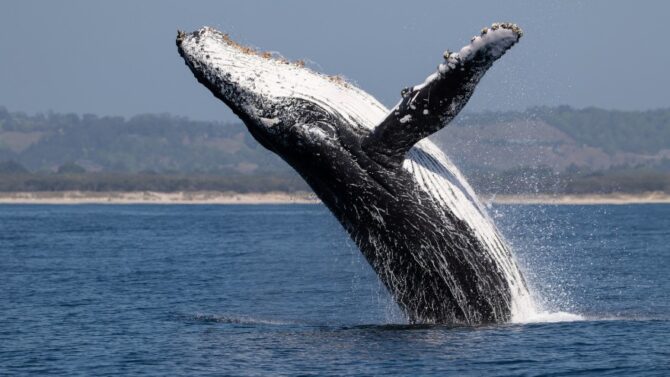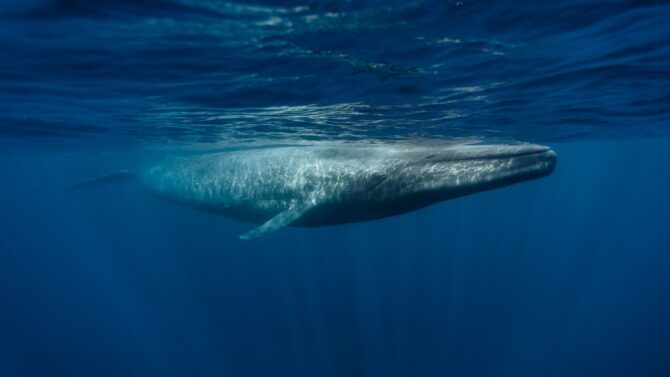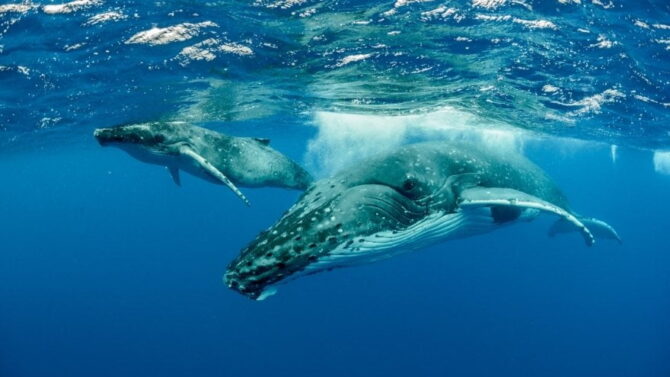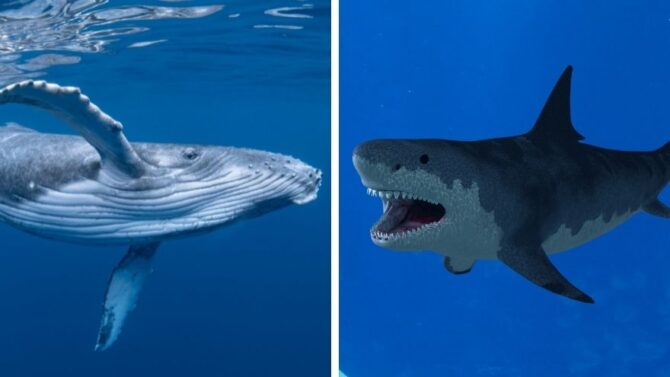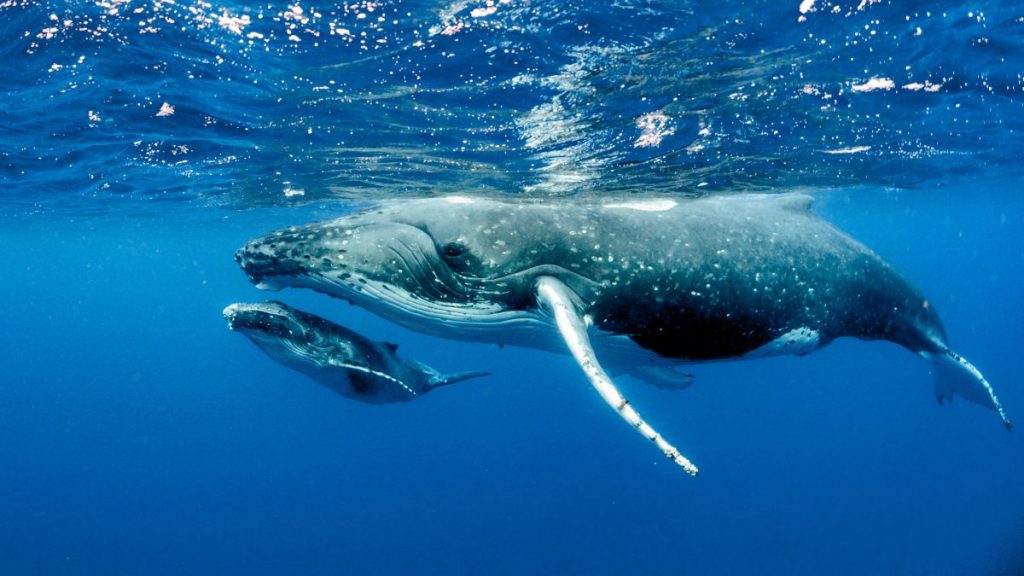Without a doubt, whales, the world’s heaviest animals, need a lot of food to keep them active in the deep sea.
As members of the order Cetacea, these mammals enjoy a wide range of menu options and are never shy to feed on the ocean’s tastiest meals.
But what do whales eat, exactly?
Generally, not all whales eat the same thing, as they have different biological modifications determined by their suborder.
Even whales grouped under one suborder have varied preferences but are always in for a treat.
Toothed whales (order Odontoceti) have sharp teeth and prey on fish, squids, and other small animals. In contrast, Baleen whales (order Mysticeti) have baleen plates instead of teeth, which serve as a filter. They feed by trapping and filtering a large amount of prey, like krill and small fish.
In this article, we’ll take a closer look at whales’ diet and position in the food chain.
What Do Whales Eat?
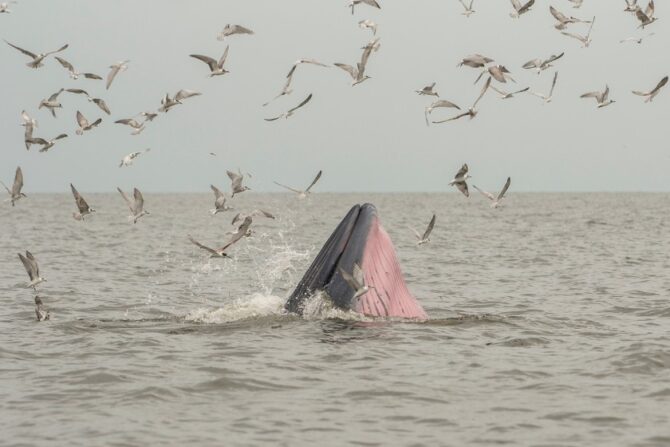
As we mentioned earlier, a whale’s suborder is the primary determinant of its diet, and the presence of dentition determines what suborder a whale belongs to.
Baleen whales are omnivorous, feeding on plants like algae and animals like fish and krill.
They filter huge volumes of water and trap their food in their mouths.
In contrast, toothed whales are carnivorous and ferocious hunters.
The consumption rate of a toothed whale varies depending on its size.
Larger species tend to hunt and consume larger prey, like fish, octopi, and turtles.
However, some species, like the killer whale, have more diverse and exotic diets, including fish and large mammals like seals.
Which Whales Have No Teeth?
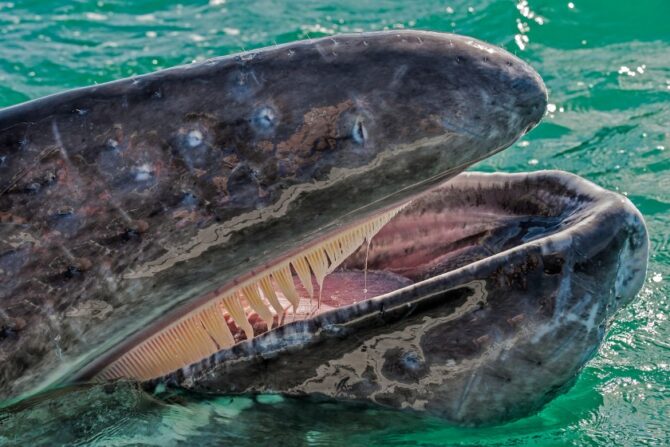
Instead of teeth, baleen whales (order Mysticeti) have baleen plates—sheets of keratin that grow from the gums of their upper jaw.
These plates are fringe-like structures that act like large sieves to catch prey, including fish, krill, algae, zooplankton, and phytoplankton.
Baleen plates are flexible but strong, as they’re made of keratin, the same substance as a human’s fingernails.
Baleen whales have enormous heads, as exemplified by the right whale, which has a head that reaches up to one-third of its body length.1
As such, they can expand their mouths and take large volumes of water, relying on their baleen plates to filter their food.
Which Whales Have Teeth?

Toothed whales (suborder Odontoceti) have conical teeth modified to hunt fish, squid, and other marine mammals.
While these whales are typically smaller than the baleen whales, they are more diverse and more adapted to hunting techniques.
Sperm whales, for example, are specially adapted for deep diving to hunt squid and other prey.
Toothed whales have well-developed hearing organs and skills sufficient for survival above or below the water surface.
Some individuals can even survive without sight, relying on echolocation to navigate underwater and locate prey.2
How Do Baleen Whales Feed?
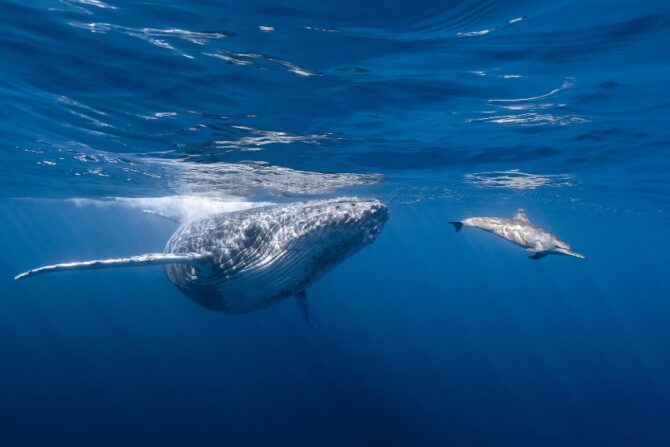
Baleen whales rely on their baleen plates to ingest food, feeding by sapping or filtering fish, krill, algae, zooplankton, and phytoplankton from the ocean.
Bottom feeders, like the gray whale, are skilled at tilting their bodies sideways and skidding the ocean floor, scooping up amphipods and sediments into their mouths.
Some species, like the right whale, are called “skimmers.”
This group feeds by swimming slowly with their large mouths fully expanded to ingest massive amounts of water and food.
Next, they pump the water through their baleen plates, keeping the food inside their mouths for swallowing.
Another baleen whale species, the humpback whale, called “gulpers,” uses a more remarkable technique to trap prey called bubble-net feeding.
These whales dive underneath a school of fish and create air bubbles by exhaling, frightening the fish to the water’s surface.
The whales then swim through the bubble net with their mouths wide open to consume the fish.
After capturing a large number of fish, they filter the water through their baleen plates and swallow their catch.
How Do Toothed Whales Feed?

Contrary to popular belief, the teeth of a toothed whale are not specialized for chewing but rather for catching, gripping, and injuring prey.
These whales possess cone-shaped teeth protruding from both their top and bottom gums.
Unlike cows and many other mammals with heterodox dentition, all the sets of a whale’s teeth are the same.
Toothed whales prefer prey larger than that of baleen whales and do not rely on an anatomical sieve to trap prey.
Instead, they actively hunt their prey.
Members of this order, like sperm whales and beluga whales, have more developed hunting skills, using sounds for hunting.
They rely on echolocation, emitting sounds that bounce off nearby prey and reveal their location.
They are also fast swimmers and are skilled at chasing prey.
These features are an advantage that keeps them at the top of the marine food chain.
How Much Can a Whale Eat in a Day?

A whale’s consumption rate depends on its size, and the variation between all species is significant.
There are over 90 species of whales, with varying amounts of daily food intake.
According to National Geographic, blue whales consume about 16 tons of plankton daily.3
Humpback whales are heavy consumers, too, foraging for food 90 percent of the time they are awake.
On average, these whales consume between 2,000 and 2,500 kg of food daily.4
While sperm whales are smaller in comparison, they still have an impressive daily intake of a little over 900 kg of food.5
Whales are certainly not lazy hunters.
They travel long distances, stay awake for long hours to hunt, and dive to great depths to obtain these large food quantities.
What Do Whale Calves Eat?

Much like terrestrial mammals, whales feed their young through lactation, providing them with nutrient-packed milk.
The milk of whales is thick and almost solid due to the high amount (35% to 50%) of fat content deposited in it.
However, the content and thickness vary across species.
Whale calves depend on their mother’s milk for their development—the high-fat content is key in building up blubber and promoting rapid growth.
Calves consume approximately 10 percent of their body weight in milk daily, amounting to around 600 kilograms of milk over a 120-day suckling period.
According to National Geographic, blue whale calves must consume about 190 liters daily, which is around 50 gallons of milk.6
Therefore, nursing females must produce large volumes of milk to sustain their young.
What Do Whales Eat in Captivity?
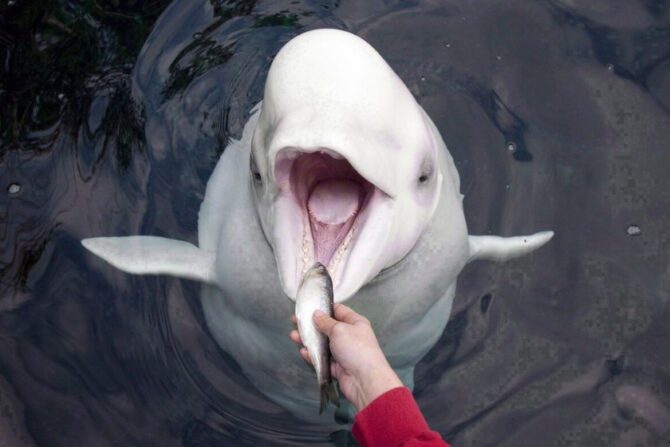
The consumption rates of whales in the wild prompt the question above for obvious reasons.
Generally, captive whales enjoy a diet similar to what their counterparts in the wild consume to ensure proper development and avoid obesity.
It’s worth noting, however, that only a few whale species are kept in captivity.
Their massive size poses a challenge as they demand enclosures that most facilities cannot provide.
Additionally, most baleen whale species require large feed quantities that no facility can realistically provide.
Among the few whale species in captivity is the relatively small pure white beluga whale.
These whales enjoy fish and shrimp and consume about 18.2 to 27.2 kg of food daily.
What Do Blue Whales Eat?

Blue whales are the world’s largest animals, ruling the ocean with their 100-foot-long bodies and weighing about 200 tons (over 181,430 kilograms).
These titanic sea beasts undoubtedly need to consume a lot of food to survive.
However, despite their immense size, they feed almost exclusively on krill, small crustaceans about 6 cm long.
At this point, you might be wondering how an animal so small can satiate the appetite of a creature so large.
Well, that’s because blue whales can consume up to 6 tons of krill daily!7
Frequently Asked Questions
What Do Great Whales Eat?
All 13 species of great whales have baleen plates, except the sperm whale.
These whales enjoy an assortment of food, including fish, octopi, turtles, seals, algae, krill, zooplankton, and phytoplankton.
What Do Whales Do to Look For Food?
While all baleen whales are filter-feeders, most individuals have a unique feeding technique.
Gray whales are bottom feeders, skidding the ocean floor to scoop up amphipods and sediments into their mouths.
Right whales are skimmers.
They feed by swimming slowly with their large mouths wide open to ingest massive amounts of water and food.
Afterward, they filter the water through baleen plates and trap the food inside to swallow.
Humpback whales are called gulpers, and they use the bubble-net feeding technique to catch prey.
Unlike baleen whales, toothed whales have teeth and actively hunt for their food.
How Long Do Whale Calves Suckle For?
The long list of different whale species accounts for the varying length of breastfeeding among calves.
However, baleen calves have shorter lactation periods than toothed whales.
While some baleen whales lactate between five and seven months, toothed whales may use one to three years, trying other food sources as they continue suckling.
Do Whales Eat Meat and Plants?
Toothed whales are carnivorous, eating fish, turtles, seals, and other marine life.
Baleen whales, on the other hand, are omnivorous, with a diverse diet that includes algae, plankton, fish, and krill.
Wrapping Up
Whales are some of the world’s largest consumers, with a rich diet that includes a wide variety of marine animals, like crustaceans, fish, and some mammals they share the ocean with.
With their immense size and active lifestyle, whales must eat a lot to remain active in the water.
During nursing periods and specific weather conditions, they may need to consume even more food to meet their energy demands.
Fortunately, the ocean provides an abundant supply of food to satisfy these animals’ nutritional demands.
Also, people are working intentionally to aid conservation efforts focused on sustaining the ecosystems that whales live in.
References & Notes
Facts Sources:
- Right Whales. National Geographic
- Whales, dolphins and sound. DCCEEW
- Whales eat three times more than previously thought. National Geographic
- Whales. Westfield State University
- Sperm Whale. Oceanwide Expeditions
- Exclusive Video May Show Blue Whale Calf Nursing. National Geographic
- Blue Whale. NOAA Fisheries
